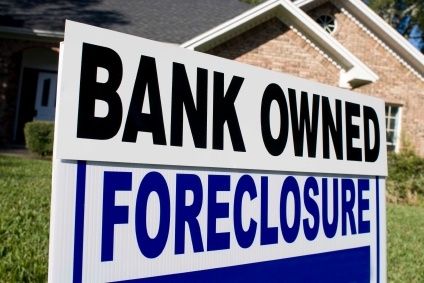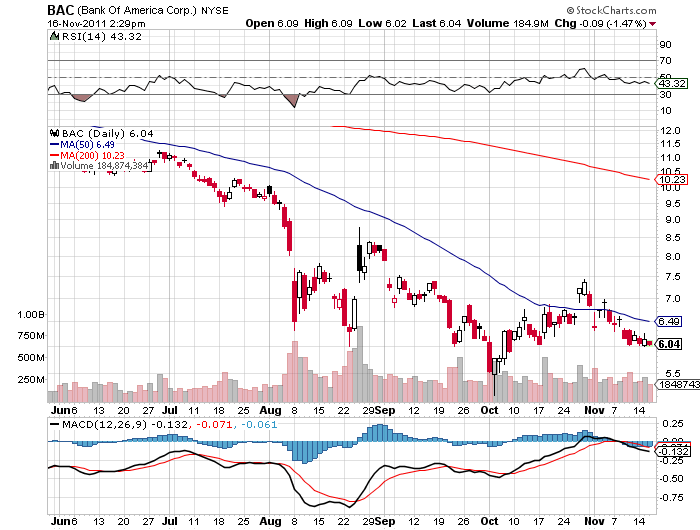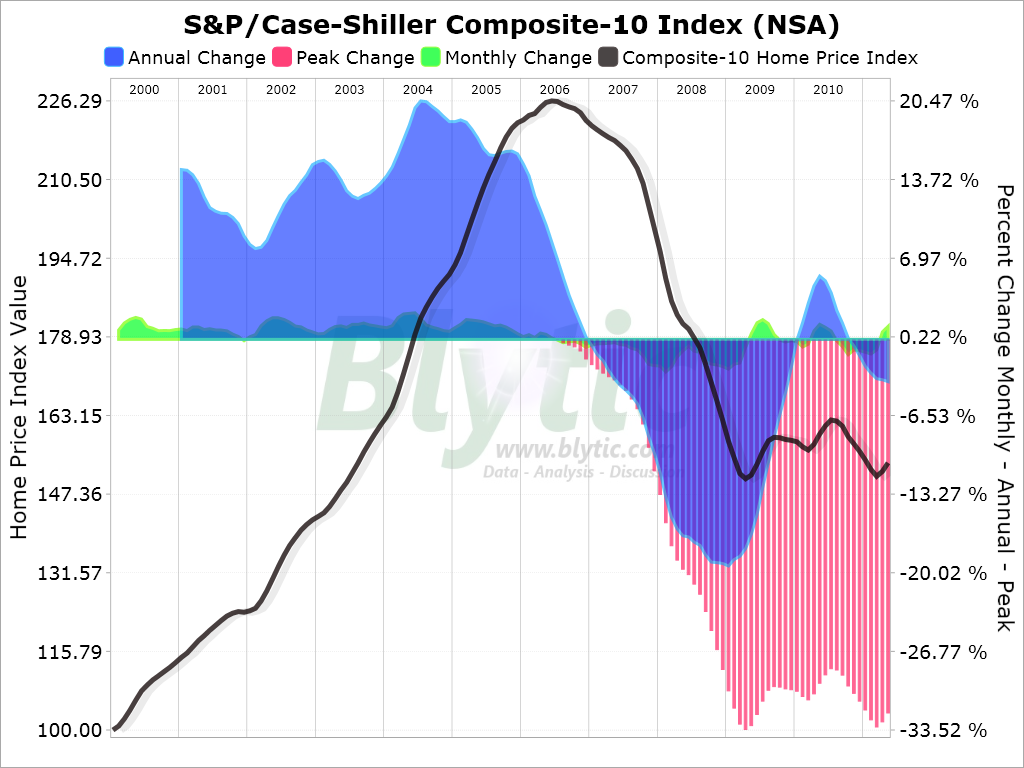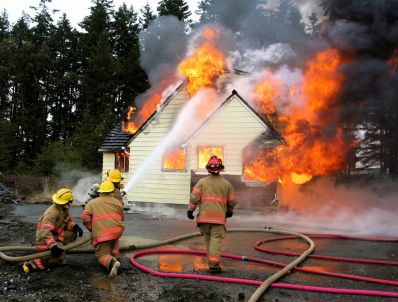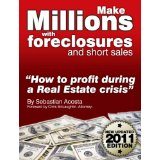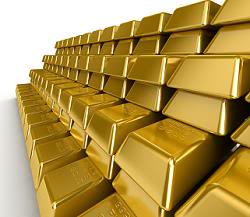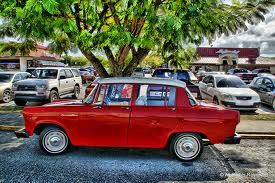?We know things are upside down when we have an Italian central banker and a German pope. That?s not the way it is supposed to be,? said Steve Cortez of Veracruz Research.
One of the most frequently asked questions at my recent round of strategy luncheons, seminars, and keynote speaking engagements has been ?Is it time to buy a home?? I responded with ?No, no, a thousand times no,? and proceeded to rail off the countless reasons. My answer always piques listeners? interest, as 67% of Americans are still homeowners, and probably more at these assemblies.
My expectation is that house prices have another 25% to go before we reach a final bottom. Of course, such comments invite truckloads of abuse from the real estate industry, which has been insisting that a recover is just around the corner for at least five years now. For those of you who were unable to attend these events, let me list off everything that will go wrong with real estate over the next two years:
*80 million baby boomers are attempting to sell their homes to 65 million Gen Xer?s who make a lot less money than their parents did. Don?t plan on selling your house to your kids, especially if they are still living rent free in the basement.
*Fannie Mae and Freddie Mac, which are currently refinancing 95% of US home mortgages, are in receivership. Having wiped out their capital in the housing crash, they are unlikely to get refunded by congress. A wholly privatized home loan market is likely to raise borrowing costs by 200 basis points, as it already does in the non-conforming jumbo market.
*Get ready to say goodbye to that home mortgage deduction as part of any budget balancing effort in Washington. This government subsidy, worth $13,000 per homeowner with a mortgage less than $1 million, is costing the government $250 billion in tax revenues annually. Any flat tax proposal does the same thing. How long should renters continue to subsidize homeowners?
*Ben Bernanke?s ?twist? program has dramatically flattened the positive yield curve, depriving banks of recapitalizing themselves with the shrunken positive carry. This is what bank share prices have been telling us with their horrific performance, with lead stock Bank of America (BAC) plunging from $14 to $5 in just six months. Translation: fewer bank loans for you and I mean lower house prices.
*Look at the chart of September Case-Shiller data below. Despite the greatest real estate stimulus in history, prices have flat lined in for two years. The 30 year mortgage is under 4%, a 60 year low, and affordability is at a 60 year high. Until this year, buyers in California were getting a combined state and federal tax breaks of $18,000 to buy a house. What happens when the stimulus ends?
* According to the Federal Reserve, 35% of US homes have less than 10% equity or negative equity. That means that 50 million homeowners will have nothing left after a sale, including closing costs. We now have negative equity states, like Nevada and Arizona.? People are trapped in their homes, and can?t move to accept new jobs elsewhere.
*To say there is an inventory overhang would be a huge understatement. There are 1 million new homes and 5 million existing homes now on the market. According to Zillow.com, another 10% of homeowners, or 15 million, would sell on any improvement in prices.
*Add up all the above, and of a total market in the US of 150 homes, there are 21 million homes for sale, and 50 million buyers shut out of the market.
*Has anyone heard there might be a recession next year? What little buying that is going on has to dry up. The expanded U-6 unemployment rate, including ?discouraged? workers and those with expired benefits, is likely to soar from the current 16% to 25% to match Great Depression highs.
*After the 1929 stock market crash, home prices took 25 years to recover pre-crash levels. I think that we are seeing a repeat of this phenomenon, with 2006 as the start date. Get ready to cash in on the new bull market in real estate in 2031, when newly enriched Millennials start to join the fray in large numbers.
With all that said, I am still looking for a home to buy. That will most likely occur on a courthouse?s steps, where cash is king. Why not, if I can get the 2020 price today, down 50% from today?s level? Until then, I will happily rent, not buy.
Is This a Sell Signal?
I was driving through a prominent San Francisco neighborhood last Sunday, looking for a McMansion open house. When I came to one key intersection there were more than a dozen signs directing me to competing offerings. What a joke. And the agent told me that market conditions were gradually improving! It looks like current and former millionaires are in a rush to unload their properties before then next recession hits, noticeably adding to the already bloated inventory of unsold homes.
I heard this morning that the Federal Housing Authority, the government agency that insures residential real estate loans, has lost nearly all its cash reserves to cover losses. Since last year, these reserves have fallen from $4.7 billion to $2.6 billion.
Federal law requires it to maintain a reserve of 2% of the $1.2 trillion of loans it currently has outstanding. Reserves will fall from 0.5% to 0.24% by 2012. Independent analysts say that the agency is underestimating loan losses by at least $50 billion.
That means the FHA will need a bail out next year, and therein lies the problem. In its current gridlocked mode, it is highly unlikely that congress will approve the multibillion dollar refunding of a controversial federal agency. The ?let the chips fall where they may? crowd seem to have the upper hand. The FHA currently insures one third of US mortgages, up 560% since 2006, largely through the demise of its private competitors. No insurance means no loans. For you and I that means lower home prices.
The FHA specializes in loans with less than 5% down. With home prices in a six year nosedive, more than half of these are now underwater. With $30 billion in liquid capital and $1.2 trillion in outstanding guarantees, it now has a 43:1 leverage ratio. Sound familiar? The shorthand for this is that the FHA is basically a government version of Lehman Brothers begging to happen.
Even while congress is starving the FHA of new funds, it is asking the beleaguered agency to stick its neck out even more. Conforming loan limits went from $729,750 down to $625,000 on October 1. Congress wants to return to old limits. This would be a big deal for homeowners in the expensive states of California and New York. But again, action is needed.
In the end, I never made it to the open house I was looking for. Instead, I tripped across another house that was twice as nice for a third less money. With all of these cutthroat price reductions going on, continuing to rent sounds like a really good idea. The taxes, insurance, and maintenance on the last place added up to more than my current rent, and that is not even accounting for a mortgage interest expense, it I could get one.
I?ll tell you the title of the next book that I am going to read. Make Millions with Foreclosures and Short Sales: How to Profit From a Real Estate Crisis can be bought at Amazon by clicking here.
?The problem is not the new ideas, it is escaping from the old ones,? said economist John Maynard Keynes
Have you ever held a basketball underwater in a swimming pool and let go? It flies to the upside and pops you in the nose. That is exactly what gold is doing now. After the barbarous relic peaked at $1,922 on August 24, it traded like an absolute pig, giving up 20% in a matter of weeks. I managed to coin it with a couple of quick in and out trades in (GLD) puts, some doubling over a weekend. So much for the ?safe asset? theory.
You can thank hedge fund titan, John Paulsen, for the action. John gained international notoriety when he earned a $4 billion bonus after making huge bets against subprime loans going into the housing crash.
Since then, his touch has grown somewhat icy. He started out 2011 with a huge, bullish bet on US banks, a play, I confess, I never really understood. This was back when Bank of America (BAC) was trading at a lofty $14/share. As a hedge, he backed up these gargantuan positions with big holdings in gold, which quickly made him the largest owner of the ETF (GLD).
John?s P&L held up reasonably well during the first part of the year. As the banks faded, gold went from strength to strength, limiting his damage. That all changed on April 29 when global financial markets flipped into ?RISK OFF? mode and gold melted along with everything else. Its hedging capability proved to be nil. By August, John?s losses approached a near death 50%.
Needless to say, his investors failed to see the humor in the situation, and rumors of cataclysmic redemptions started sweeping the street. By implication, this could only mean large scale liquidation of the yellow metal. This was happening when the rest of the hedge fund industry was catching daily margin calls, forcing them to dump even more gold into a downward spiral, their best performing holding for the year. When the sushi hits the fan, you sell what you can, not what you want to. By the time the carnage ended, gold was down $392.
When the crying was over, Paulson had reduced his ownership in the ETF (GLD) from 31.5 million shares to 20.3 million. That?s a haircut of $1.76 billion of the shiny stuff. In the end, Paulson says he only suffered redemptions of 10% of his somewhat reduced funds, much lower than expected.
Gold actually anticipated the new ?RISK ON? trade by a week, bottoming on September 26. Since then it has behaved like a paper asset, tracking the S&P 500 almost tick for tick, adding a quick 19.6%. So, what?s up with gold?
As we approach yearend, the downward pressure of this redemption selling is waning, hence my basketball analogy. New bull arguments have also come to the fore. The contagion in Europe has prompted massive buying of all precious metals by panicky individuals, including silver (SLV), platinum (PPLT), palladium (PALL), and even neglected rhodium, with a collapse of the Euro imminent. And how will the ECB eventually end the crisis? With a continental TARP and quantitative easing, which we here in the US already know is hugely positive for gold prices.
How far will the gold get this time? The gold bugs say we?re going to break the old high and power on through to the inflation adjusted high at $2,300. I?m not so sure. I am not willing to bet the ranch here on an asset class that could plunge $1,000 going into the next recession, which could be just around the corner.
But there may be a trade here in precious metals space for the nimble. My pick has been to buy lagging silver, which offers much more bang per buck if the sector starts to build a head of steam. The white metal will not get hit with IMF gold sales, which are also a rumored part of any European bailout package.
I am constantly barraged with emails from gold bugs who passionately argue that their beloved metal is trading at a tiny fraction of its true value, and that the barbaric relic is really worth $5,000, $10,000, or even $50,000 an ounce (GLD). They claim the move in the yellow metal we are seeing is only the beginning of a 30 fold rise in prices similar to what we saw from 1972 to 1979, when it leapt from $32 to $950.
So when the chart below popped up in my in-box showing the gold backing of the US monetary base, I felt obligated to pass it on to you to illustrate one of the intellectual arguments these people are using. To match the 1936 peak value, when the monetary base was collapsing, and the double top in 1979 when gold futures first tickled $950, this precious metal has to increase in value by eight times, or to $9,600 an ounce.
I am long term bullish on gold, other precious metals, and virtually all commodities for that matter. But I am not that bullish. It makes my own three year $2,300 prediction positively wimp-like by comparison. The seven year spike up in prices we saw in the seventies, which found me in a very long line in Johannesburg, South Africa to unload my own krugerands in 1979, was triggered by a number of one off events that will never be repeated.
Some 40 years of demand was unleashed when Richard Nixon took the US off the gold standard and decriminalized private ownership in 1972. Inflation later peaked around 20%. Newly enriched sellers of oil had a strong historical affinity with gold. South Africa, the world's largest gold producer, was then a boycotted international pariah and teetering on the edge of disaster. We are nowhere near the same geopolitical neighborhood today, and hence my more subdued forecast. But then again, I could be wrong.
You may have noticed that I have not been doing much trading in gold or the other precious metals lately. That is because they are still working off an extremely overbought condition. Given some time, and a nice little dip in prices, and I'll be back there in a heartbeat. You'll be the first to know when that happens.
With smoke still rising from the ruins of the recent silver crash, I thought I'd touch base with a wizened and grizzled old veteran who still remembers the last time a bubble popped for the white metal. That would be Mike Robertson, who runs Robertson Wealth Management, one of the largest and most successful registered investment advisors in the country (click here for his site at www.robertsonwealthmanagement.com).
Mike is the last surviving silver broker to the Hunt Brothers, who in 1979-80 were major players in the run up in the 'poor man's gold' from $11 to a staggering $50 an ounce in a very short time. At the peak, their aggregate position was thought to exceed 100 million ounces.
Nelson Bunker Hunt and William Herbert Hunt were the sons of the legendary HL Hunt, one of the original East Texas oil wildcatters, and heirs to one of the largest? fortunes of the day. Shortly after president Richard Nixon took the US off the gold standard in 1971, the two brothers became deeply concerned about financial viability of the United States government. To protect their assets they began accumulating silver through coins, bars, the silver refiner, Asarco, and even antique tea sets, and when they opened, silver contracts on the futures markets.
The brothers? interest in silver was well known for years, and prices gradually rose. But when inflation soared into double digits, a giant spotlight was thrown upon them, and the race was on. Mike was then a junior broker at the Houston office of Bache & Co., in which the Hunts held a minority stake, and handled a large part of their business. The turnover in silver contracts exploded. Mike confesses to waking up some mornings, turning on the radio to hear silver limit up, and then not bothering to go to work because he knew there would be no trades.
The price of silver ran up so high that it became a political problem. Several officials at the CFTC were rumored to be getting killed on their silver shorts. Eastman Kodak (EK), whose black and white film made them one of the largest silver consumers in the country, was thought to be borrowing silver from the Treasury to stay in business.
The Carter administration took a dim view of the Hunt Brothers' activities, especially considering their funding of the ultra-conservative John Birch Society. The Feds viewed it as a conspiratorial attempt to undermine the US government. It was time to pay the piper.
The CFTC raised margin rates to 100%. The Hunts were accused of market manipulation and ordered to unwind their position. They were subpoenaed by Congress to testify about their motives. After a decade of litigation, Bunker received a lifetime ban from the commodities markets, a $10 million fine, and was forced into a Chapter 11 bankruptcy.
Mike saw commissions worth $14 million in today's money go unpaid. In the end, he was only left with a Rolex watch, his broker's license, and a silver Mercedes. He still ardently believes today that the Hunts got a raw deal, and that their only crime was to be right about the long term attractiveness of silver as an inflation hedge.
Nelson made one of the great asset allocation calls of all time and was punished severely for it. There never was any intention to manipulate markets. As far as he knew, the Hunts never paid more than the $20 handle for silver, and that all of the buying that took it up to $50 was nothing more than retail froth.
Through the lens of 20/20 hindsight, Mike views the entire experience as a morality tale, a warning of what happens when you step on the toes of the wrong people.
And what does the old silver trader think of prices today? Mike saw the current collapse coming from a mile off. He thinks silver is showing all the signs of a broken market, and doesn't want to touch it until it revisits the $20's. But the white metal's inflation fighting qualities are still as true as ever, and it is only a matter of time before prices once again take another long run to the upside.
Silver is Still a Great Inflation Hedge
Pound away at this market all you want, and it just refuses to go down. In recent weeks we have received a torrent of bad news from Europe, including the fall of governments in Greece and Italy, and the S&P 500 index keeps migrating back to the 1,260 level, as if attracted by some supernatural, magnetic force. It is no coincidence that this is where the closely followed big cap index is dead unchanged on the year.
At this stage, both traders and markets are worn out by the contentious and eye popping moves of the past four months, so we might expect volatility to decline going into the yearend holidays. But watch out for the upside surprise. Expectations are very low here, so the slightest positive development could break the market through resistance at the 200 day moving average. Think of it as the errant child you expect an ?F? from, and he brings home a very strong ?C-?.
The November-December time frame is historically the second most profitable part of the calendar, rising 70% of the time. Only March-April are better. We have a nice year end liquidity push setting up. Every momentum indicator I follow has markets healthy until mid-December. Think of the index as a coiling spring, building up energy for one last blast to the upside.
Crude oil is also suggesting that the ?RISK ON? trade is alive and well, with $100 a barrel clearly in its sites, and after that $110. This has nothing to do with supply/demand fundamentals, or the rising consumption in China. This is purely the hedge funds and high frequency traders at work, getting a small assist from new nuclear worries over Iran and delayed production recovery in Libya. Keep relying on Texas tea for your risk direction.
Of course, you didn?t know that your job description was changed overnight to that of ?Head Italian Sovereign Debt Trader.? That is effectively what we have all become, with yield spikes for their ten year paper triggering asset fire sales in the US, only to see falling Italian interest rates send prices here soaring the next day. I think I liked Italy more when it was better known for great pasta, fine opera, and beautiful women. Keep using every Euro induced puke out to scale into long positions in American risk assets.
Ditto also for the Euro, which has become the currency everyone loves to hate. Forecasts for an end 2011 decline go all the way down to $1.29. That?s probably why it is bleeding so slowly. Any good news from Europe is prompting the European currency to rally back up to the top of a negatively sloping channel. Take these as the gifts that they are and increase shorts on the Euro through buying puts on the (FXE), or buying outright the inverse ETF (EUO). If the two charts below aren?t showing a head and shoulders downward move, then I deserve a trip to the guillotine.
If any of my three black swans decide to alight, it could be off to the races. Those include another surprise cut in European interest rates, a midnight deal by the Super committee, a sudden cut in Chinese interest rates, or all of the above.
I don?t want to confuse you here. I have not turned into a hyper bull. I just think we could get one last gasp to the top end of a multiyear range that could take us as high as 1,325 or 1,350 in the (SPX). The bill for this move won?t be due until next year. Haven?t we gotten good at kicking the can down the road? As my old friend and mentor, Barton Biggs, used to say, ?Always leave the last 10% of a move to the next guy.?
?I?d rather own silver than Toyota in an environment like we are having now,? said Jim Rogers, CEO of Rogers Holdings.
I am writing this from the polished teak floored, white columned, veranda of the historic Raffles Hotel in Singapore. Exotic tropical birds with huge curved bills are calling each other from the betel nut trees. I am somewhat peeved, as the Sir Stamford Raffles Suite which I have reserved is not yet available. A visiting head of state shacked up with his mistress has overstayed his booking, and the hotel is afraid to boot him out, lest they cause an international incident.
The manager couldn?t be more apologetic, and mollified me with a complimentary breakfast, $300 worth of spa credits, and unlimited use of the hotel limo for the duration of my stay.
I was in a crabby mood to start with. Singapore Airlines screwed up my booking, so instead of getting the full length bed I was expecting for the eight hour overnight flight from Brisbane, Australia, I ended up with a less than compromising standard business class seat. By the time I landed at 6:00 am the next morning, I was so sore that I felt I had just played for the losing Australian team in their rugby world cup match against New Zealand?s unbeatable All Blacks. The things I do for this letter.
When I walked out of the cavernous airport, the humidity slapped me in the face, fogging up my glasses. With Singapore a scant one degree and 22 minutes north of the equator, I arrived at the height of the Northeast monsoon, and it was 90 degrees and raining.
And the dawn rose like thunder.
Every time I poke my foot out the door, a deafening clap of thunder struck and a torrential downpour ensued, sending palm fronds flying. So this will be a writing day.
On arrival, I did what all returning Singaporeans do in time honored tradition. I went to McDonalds and had a sausage and egg McMuffin. Meet the face of globalization.
Meet The Happy Face of Globalization
Singapore has been an economic miracle for as long as I can remember. It was the first place American electronics multinationals offshored during the 1960?s, when China was still locked up tighter than a drum and in the throes of the Cultural Revolution. Since then, the country made itself an entrep?t of international trade. It is the region?s largest oil refiner. It created an educated and efficient workforce that was the springboard to making Singapore a major services hub for banking and securities markets.
Private technical schools are absolutely everywhere, and sociology majors are far and few between. Not a penny was spared on the construction of its impressive infrastructure. Much of the Asian bulk shipping fleet lies at anchor, loading, unloading, or awaiting charters, drawn by world class ship repair facilities. When the Middle Kingdom finally joined the globalization gravy train, Singapore caught the spillover. The island nation of 3 million is now one of the leading centers for the management of the immense wealth earned by high net worth Chinese. The place is swimming in money. Singapore ranks 14th in the world in imports, 15th in exports, and is the 5th busiest port in the world. Inhale here, and you are tasting the intoxicating air of prosperity.
The credit for much of this success can be laid at the feet of the autocratic former Prime Minister, Lee Kwan Yew, who ruled the country with an iron fist for 23 years. Littering can still earn you a public flogging with a painful rattan. I still hold a grudge against Mr. Lee because he regularly locked up friends of mine at The Economist and the now defunct The Far Eastern Economic Review whenever they ran an editorial he disagreed with. Still, it?s hard to argue with success.
This year, Singapore?s GDP will grow a blistering 5%-6%, a rate Americans would kill for. Inflation is rising at 5%. The Singapore dollar, now worth 81 cents, is as good as gold, and has been rising consistently for 40 years. Singapore ten year government bonds, yielding a mere 1.62%, are one of the few top sovereign credits still out there. They are one of handful worth buying in the world, along with those of Brazil, Australia, and New Zealand. Needless to say, Singaporean stocks (EWS), bonds, and currency have all been favorite hedge fund targets for years. They are ?RISK ON? trades with a turbocharger. Buying stock exposure there at recession lows, such as through the ETF (EWS), has been a multi decade winner, and will continue to be so for the foreseeable future.
The Raffles has been a crossroads for Asian travelers since it was built by four Armenian Brothers in 1887. Rudyard Kipling, Somerset Maugham, and Noel Coward were regular residents. A tiger was shot in the billiard room in 1902. The ?Singapore Sling? was invented in its famous Long Bar, just off Cad?s Alley, as a polite way for women to drink gin. During WWII, my late father-in-law, Masao Taguchi, was stationed here as a paymaster for the Japanese Army.
I first stayed at the Raffles in 1974, when the floorboards sagged, the threadbare carpets threw off a musty smell, and the white plaster was peeling off the mildewed walls. I used to play billiards there with the war correspondents covering the dying embers of the Vietnam War, the felt on the enormous tables frayed and insulted with countless cigarette burns.
In 1991, the hotel underwent a down to the foundations reconstruction, and was later sold to the government of Dubai. Today it is considered one of the best hotels in the world, along with the Cipriani in. Service is offered here in the extreme, my personal butler, Alvaro, assigned to me upon check in (yes sir, no problem getting those suits pressed and shoes shined in 20 minutes). The same billiard tables are still there, with new felt to boot.
I Last Played Here in 1974
Singapore also amazes observers with its ambitious social experiment. This was a malarial swamp when the British East India Company set up a trading post in 1819, so everyone here is from somewhere else. Today, the population is evenly split between the decedents of British colonials, overseas Chinese, Indians, and Malaysian bumiputras.
It is fascinating listening to the locals communicating with each other in fractured versions of the national language, English, which is really of form of pidgin. Even the local Chinese dialect blends in a lot of random English words. The racism of the colonial past has long since disappeared. Today everyone seems to get along, worshipping the common god of commerce.
Check Out My New Digs
My Singapore Global Strategy luncheon was a blowout success, with late minute additions packing the room at the American club beyond its legal capacity. Was it something I said? Afterwards, one reader invited me to sail with him from Phuket to Penang next time I was in town. I asked if this was safe, since the Straits of Malacca were invested with pirates. Having covered their depredations on the Vietnamese boat people during the seventies, I know them too well as a savage and pitiless bunch. He said yes, that was true, but as long as they were paid off in advance, they left you alone. That worked for me, as it was better than the alternative. No kidding.
I spent my last night in the island nation as the dinner guest of some local magnates and soldiers of fortune. Note to self: never tell the Chinese you?ll eat anything. The Peking duck, peppered crab, and the rare, raw Canadian geoduck shellfish were excellent. However, I passed on the monkey brains and snake bile, citing my doctor?s admonition to avoid these delicacies due to their high cholesterol content.
?As my plane taxied downed the runway for takeoff, I wondered how many bones of allied soldiers we were passing over. My late friend, James Clavell, spent 3 ? years here at the notorious Changi POW camp during WWII. His ordeal became the basis for the bestselling novel and Hollywood film, ?King Rat?.
I asked the flight attendant if we would pass over Vietnam and Cambodia on the way to Hong Kong. When she said ?yes?, the first thing that came to mind was ?Damn, hope we don?t can catch another burst of machine gun fire again.? There are still bits and pieces of me down there, and whenever I pass by the neighborhood, they speak to me.
Oh, and if anyone needs pirates in the Straits of Malacca dealt with, just send me an email. I?m your guy.
Legal Disclaimer
There is a very high degree of risk involved in trading. Past results are not indicative of future returns. MadHedgeFundTrader.com and all individuals affiliated with this site assume no responsibilities for your trading and investment results. The indicators, strategies, columns, articles and all other features are for educational purposes only and should not be construed as investment advice. Information for futures trading observations are obtained from sources believed to be reliable, but we do not warrant its completeness or accuracy, or warrant any results from the use of the information. Your use of the trading observations is entirely at your own risk and it is your sole responsibility to evaluate the accuracy, completeness and usefulness of the information. You must assess the risk of any trade with your broker and make your own independent decisions regarding any securities mentioned herein. Affiliates of MadHedgeFundTrader.com may have a position or effect transactions in the securities described herein (or options thereon) and/or otherwise employ trading strategies that may be consistent or inconsistent with the provided strategies.




